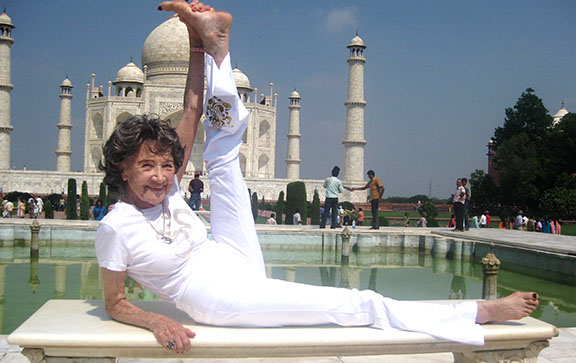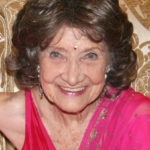
Tao Porchon-Lynch, in front of the Taj Mahal, 2010.
On February 21, 2020, the Yoga world lost one of its icons: Tao Porchon-Lynch who was 101 years old. Tao was beloved by young and old, and in addition to being the oldest living Yoga teacher (named as such by the Guinness World Book of Records) she was also an accomplished ballroom dancer who was still dancing with the Fred Astaire Society and teaching Yoga up until her death!
In 2019, Sri Narendra Modi, Prime Minister of India awarded Tao one of its country’s highest honors and so well-deserved: the Padma Shri Award. Satchidananda Ashram–Yogaville and Integral Yoga International join all Yoga enthusiasts around the globe to pay tribute to this one-of-a-kind Yoga luminary! Our thoughts and prayers are with her and all whom she loved and loved her. We have no doubt that she will be dancing and flying on angels’ wings!
Tao taught programs at various Yoga centers, including Yogaville and the Integral Yoga Institute of New York. In her honor, we reprint an interview we did with her in 2010. This interview brought the world’s oldest Yoga teacher together with one of the world’s youngest Yoga teachers and rising stars, Tara Stiles. Please enjoy the interview below, which was originally titled:
“The Grande Dame of Hatha Yoga and the New Kid on the Block: An Interview with Tao Porchon-Lynch and Tara Stiles”
Extraordinary leaders and teachers change the way we perceive the world. The very best lead us by their example. Tao Porchon-Lynch, a former actress, 92-years young and the first female student of BKS Iyengar is one such Master Yoga teacher. Tara Stiles, age 29, has blazed onto the Yoga scene and has been proclaimed by Vanity Fair magazine as “the coolest Yoga instructor ever.”
Tao has taught Yoga since the 1970s and certified 400 other teachers. Until recently, before she broke her wrist, she was able to suspend herself by her hands in the full-lotus and peacock positions. She’s still a competitive ballroom dancer, despite undergoing hip replacement five years ago. “I’m not going to give up. I’m going to dance and do Yoga for as long as I live,” she says. Tara Stiles is reinventing what it means to practice Yoga while proving that you don’t need to wear spandex or call yourself a “Yoga person” in order to make it part of your life. As the resident expert of the Women’s Health Yoga Channel, Tara promotes the ideology of “Yoga for everyone.” She recommends incorporating it into your everyday routine, whether you’re at the office or sitting on the couch. We have a special opportunity to hear from a young Yoga teacher and a young-at-heart Yoga teacher about issues facing the practice and teaching of Hatha Yoga today.
Integral Yoga Magazine (IYM): Both of you began your careers as models and you also have been actresses. How did you get into Yoga?
Tao Porchon-Lynch (TPL): My mother died during my birth, and my father (who had immigrated to Canada from India) was not able to care for a tiny baby. So he sent me to Pondicherry to be raised by my aunt and uncle. My uncle belonged to Aurobindo Ashram and was a close friend of Mahatma Gandhi. My aunt didn’t consider it ladylike to do Yoga but, when I was eight-years-old, I insisted on trying it, and my uncle encouraged me. Later, I moved to Europe and began modeling and acting in films. In 1950, I discovered the Vedanta Society in Hollywood and met Swami Prabhavananda. I used to go there to be with him, Christopher Isherwood and Aldous Huxley. We’d sit on the floor with the swami, and he would teach us the philosophy, which was wonderful.
Tara Stiles (TS): I grew up in Illinois, where I studied ballet and dance. When I was a teen, part of our dance schedule included Yoga for relaxation and reducing soreness. I really enjoyed the Yoga and wanted more. My ballet teacher gave me the classic book, Autobiography of a Yogi, and I loved it. I became a Ford model and, at 18, moved to New York and began taking various classes and exploring different styles of Yoga.
IYM: How important is the physical part of Yoga?
TPL: If you don’t water plants, they die. Hatha Yoga is necessary to first feel that, like a tree, you are grounded and well watered. The Chinese have saying: The tunnel in our instep makes energy flow upward and blossom. If we can take some of the pain out of our bodies and out of our thoughts then the energy can move upward. When people first begin Hatha Yoga, they will sit slumped down. How can you breathe? You are imprisoning the heart! You need the spine to be erect to feel the energy flow through. The postures in Hatha Yoga are to help the energy travel through us, and then we can think of the Creator being alive in us.
TS: The physical part of Yoga is a really direct way to connect into your body and own your awareness and intuition. My goal is to get people back into their bodies, to attune to their own intuition and guidance rather than looking outside themselves—whether looking to celebrities or others—for their sense of worth. I think we can help people get more present in their lives by first getting them connected to their bodies
TPL: In many cases, people walk into studios and they sit down and don’t even make contact with the person next to them. I think we need to get away from the fear of life. Fearful thoughts materialize. When my students come in, everyone knows each other. When we start, we feel the presence of each person and know that we have nothing to be afraid of. We are in tune and that energy in the room is vital. It’s important to get that oneness where we join together to bring peace into the world.
TS: I don’t see a difference between Hatha Yoga and other parts of Yoga. I can tell everything about you—and you can tell everything about you—by how you bring your foot forward in a pose. If you are lazy, if you are someone who tries hard but is not efficient, if you push yourself, if you are hard on yourself—all that reveals itself in Hatha class. Hatha can address that and lead you into more conscious living and into the other practices of Yoga. You should be meditating when you are on the mat and in your whole life. So, I don’t see a difference between the practices and life.
IYM: What about the spiritual aspects of practice?
TPL: To join our bodies, minds and spirits is Yoga. We need a good, healthy body, but unless our practice comes from within, from the breath of life, we are not doing Yoga— we are only doing a form of physical exercise. When we are in touch with the breath of life, we are in touch with the Creator of life. Nothing is impossible when we feel this. Some people come into a class and say, “I’m so tired. I can’t do this and that.” But I say, “There’s nothing we can’t do. We aren’t the doers; we are the instruments. If you can feel that power in you, it opens up the door to everything.”
TS: I think, as Yoga teachers, we give people the opportunity to go as deep as they want. That may be the theme of my generation: Just try Yoga. You don’t have to go away to an ashram somewhere for six months or go to India. Just give people easy access to take a Yoga class, make it affordable, make it accessible and relatable. When you do the physical Yoga, you feel good. So, then maybe you want to start eating healthier; then maybe you start treating your family and friends more gently. My generation is attracted by the health benefits of Hatha Yoga. I think Hatha is a good way to get them in touch with their bodies and then through that, the direct experience of Yoga. There aren’t “spiritual moments.” All moments are spiritual.
IYM: What do you try to convey to your students?
TPL: I tell all my students, “Don’t be in a hurry. Do the posture and get to the essence of the posture.” I want the teachers I train to have compassion. Some don’t encourage their students. They don’t tell anyone they are good unless they do a pose perfectly. I teach a lot of students who are older and who are afraid that can’t do the poses. We should always encourage people. If they move only one inch, tell them they are on the right path. I was teaching at a senior center once where it looked like they were waiting to die. They were all so fearful and negative. I told them, “I wear high heels,” and they said, “That’s okay for you but we are old.” The oldest was 78. I said, “I’m 89!” I don’t believe in just walking around and talking. I do all the postures with my students, so with that, they got up and tried to follow me. We can’t retire from life, we can only go on and blossom, whatever the age. We can inspire people to live. That’s most important. Teachers should inspire others to live and to feel the essence of life.
TS: What I try to convey is that Yoga has always been here. I want my students to discover the power of Yoga from their own experience, as others did thousands of years ago. We all have already in us the intuition to find the right way to our own health, spirituality and whatever else we need. I just want to be sure the students are doing the poses correctly and beyond that, I don’t feel I have to say much more. Yoga works every time and you see people get happy, and I feel lucky I get to share in that all the time. All the studies that have been done show us that Yoga works, but even beyond all the studies, you feel really good after physical Yoga and meditation. When people feel good, they start to eat healthier and make healthier lifestyle choices and that continues to lead them into other aspects of Yoga.
IYM: What are some common misconceptions about Yoga?
TS: That only certain types of people practice Yoga, that it is somehow for the spiritually elite. People often have negative ideas about Yoga because of behaviors embodied by some leaders and people in Yoga who charge $10,000 for training programs or create cliques and clubs. I was shocked to encounter attitudes like, “I am better than you because I do Yoga. What do you mean: You are better? It’s kind of like a bullying thing—it becomes like high school all over again. I’m trying to convey that Yoga is for everyone. It’s not something weird, it’s not just for tree hugging people, it’s not a cult and all the other misconceptions. Because once you do Yoga, it’s like you want everyone to experience the benefits.
TPL: I think that many people have the misconception that Yoga is jumping into each posture or twisting oneself into some pose. They are making up so many different names these days, now animal Yoga is popular! Yes, you can learn a lot from animals, but the point is that it’s a time when people are bringing a lot of crazy things in to make it more commercial. In India, you are told to practice Hatha Yoga outside in the morning because you need air.
IYM: Do you have other concerns?
TPL: I’m in favor of everybody, but just jumping up and down is not Yoga. Many are using props these days. Okay, you can use certain things but you don’t have to rely on them for the rest of your life. Otherwise, you are not using your body and the creative energy within you. It’s important to feel the energy, to learn how to breathe. When you do a posture, you don’t just fall into it. The breath moves outwards from within. Unless you are in touch with what’s inside you, you are just doing physical culture.
TS: Doing Yoga in New York City should be something that isn’t a luxury. You shouldn’t have to pick between going to a Hatha Yoga class and having dinner. At my studio, it’s $10 for a class and that gives people the enthusiasm to come several times a week. At the end of the week, they may have paid the same as other studios charge, but they’ve been able to practice more than once a week, and I think they see a lot of benefit in that.
IYM: What do you hope to see for the future of Yoga?
TPL: What I hope is that we go back to the seed of Yoga, to the essence a little more. Yoga isn’t acrobatics or aerobics. There’s a saying in India, “One proper breath, puts one year to your life without pain.” I think the important points are: to learn to breathe, to be a part of the universal spirit, to get rid of your noisy thoughts and not let them penetrate your body, to not let your mental pride get in the way. Hatha Yoga can help free you.
TS: I love how technology is helping to bring Yoga to people. YouTube is filled with great Hatha classes. Deepak Chopra and I developed an iPhone app (“Authentic Yoga”). The idea was that even if you don’t live near a studio or are intimidated to go you can begin with the iPhone. It’s not just the content being put out, but it’s exciting to have conversations and connect with others via all the social media. My hope is that everyone tries Yoga and understands that it’s not something weird. The practices of Yoga work and they can really enrich your life.
IYM: Why don’t we give our Grande dame of Yoga teachers the last word?
TS: I agree!
TPL: Thank you. As I always say, there is nothing we cannot do if we harness the power within us.
 Tao Porchon-Lynch has trained and certified hundreds of Yoga instructors, since founding the Westchester Institute of Yoga in 1982. She has over 70 years of Yoga practice and more than 45 years of teaching Yoga to students in India, France and the United States. Having studied with Indra Devi in Pondicherry and BKS Iyengar in Pune and Mumbai, Tao learned how to tap into the incredible power all individuals possess but only few can access. She has made over twenty-five pilgrimages to India with her students because she believes that such visits offer enlightenment about the true spirit of Yoga. Tao continues to teach workshops at many Yoga centers. For more information, please visit: www.taoporchon-lynch.com.
Tao Porchon-Lynch has trained and certified hundreds of Yoga instructors, since founding the Westchester Institute of Yoga in 1982. She has over 70 years of Yoga practice and more than 45 years of teaching Yoga to students in India, France and the United States. Having studied with Indra Devi in Pondicherry and BKS Iyengar in Pune and Mumbai, Tao learned how to tap into the incredible power all individuals possess but only few can access. She has made over twenty-five pilgrimages to India with her students because she believes that such visits offer enlightenment about the true spirit of Yoga. Tao continues to teach workshops at many Yoga centers. For more information, please visit: www.taoporchon-lynch.com.
 Tara Stiles is an American model turned Yoga instructor and the founder of Strala Yoga. Stiles has been featured in numerous magazine pictorials as well as TV commercials. She is the face of Yoga for Women’s Health magazine, a columnist for the Huffington Post and is featured in Nissan’s Master the Shift national ad campaign. Tara is also the personal Yoga instructor to Deepak Chopra, with whom she collaborated to create Authentic Yoga for the iPhone. Her “Tara Stiles Yoga Videos” are featured on YouTube and her new book, Slim Calm Sexy, will be published in August. For more information, please visit: www.tarastiles.com.
Tara Stiles is an American model turned Yoga instructor and the founder of Strala Yoga. Stiles has been featured in numerous magazine pictorials as well as TV commercials. She is the face of Yoga for Women’s Health magazine, a columnist for the Huffington Post and is featured in Nissan’s Master the Shift national ad campaign. Tara is also the personal Yoga instructor to Deepak Chopra, with whom she collaborated to create Authentic Yoga for the iPhone. Her “Tara Stiles Yoga Videos” are featured on YouTube and her new book, Slim Calm Sexy, will be published in August. For more information, please visit: www.tarastiles.com.
(Reprinted from Integral Yoga Magazine, Summer 2010 issue)

